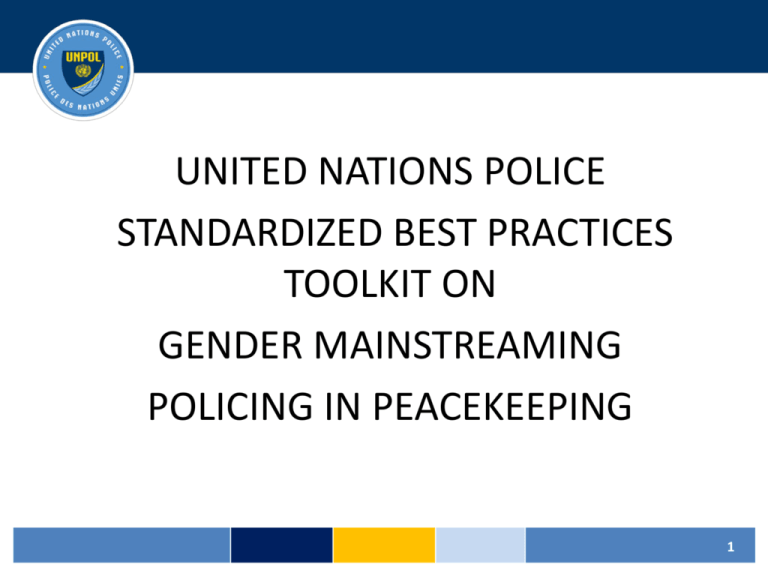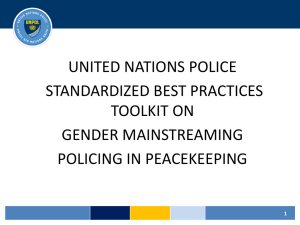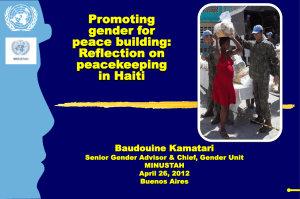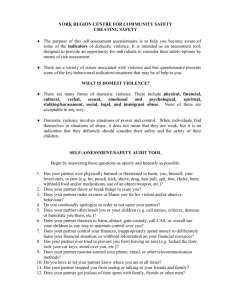Module 3 Lesson 1 Introduction to SGBV
advertisement

UNITED NATIONS POLICE STANDARDIZED BEST PRACTICES TOOLKIT ON GENDER MAINSTREAMING POLICING IN PEACEKEEPING 1 UNPOL GENDER TOOLKIT MODULE 3 LESSON 1 UNDERSTANDING SEXUAL AND GENDER-BASED VIOLENCE (SGBV) AND CONFLICT-RELATED SEXUAL VIOLENCE (CRSV) 2 3 Learning outcomes Define SGBV and CRSV Analyse the specificities of crimes related to SGBV and CRSV Analyse the barriers for police in addressing SGBV and CRSV Apply the appropriate legal policy framework to cases of SGBV and CRSV 4 JEOPARDY 5 Rules of the game Each time, a group selects a category and a question The group has 30 seconds to provide only one answer If group does not answer properly, a representative of every other group races to the board for a chance to answer Race restarts between other participants until one answers accurately 6 Concepts and definitions Legal framework and policing General information 7 What is conflict-related sexual violence? 8 Any form of sexual violence of comparable gravity, perpetrated against women, men or children with a direct or indirect link to a conflict, which may be temporal, geographical or causal. 9 What is sexual violence? 10 Sexual violence, including exploitation and abuse, refers to any act, attempt or threat of a sexual nature that results, or is likely to result, in physical, psychological and emotional harm. 11 What is the difference between SGBV and CRSV? 12 Conflict-related sexual violence (CRSV) is a type of SGBV which may be used as a method of warfare to humiliate enemies and undermine their morale, terrorise and control civilians, force communities out of their homes, affect ethnic balance. 13 Mention one resolution which has placed conflict-related sexual violence (CRSV) on the international peace and security agenda 14 Resolutions1820 (2008), 1888 (2009), 1960 (2010) and 2106 (2013) have placed conflictrelated sexual violence (CRSV) on the international peace and security agenda. 15 Which thematic areas of Security Council resolutions cover sexual violence in conflict? 16 • Women, peace and security • Protection of Civilians • Child Protection 17 Give an example of a barrier to policing in cases of SGBV 18 Deeply personal effect on victims, serious emotional impact of SGBV, social myths and stereotypes, sense of betrayal, self-blame, health consequences, high potential for revictimization, or sense of insecurity 19 Cite at least four reasons for the underreporting of SGBV 20 • • • • • • • • • • • Physical and psychological trauma; Young age, disability; Threats, fear of retaliation, manipulation; Feelings of shame, self blame; Pressure from family; Protection of the perpetrator, in particular if a family member; Stigma from community; Fear of being blamed, not believed or mistreated by police; Lack of confidential areas in police stations and trained officers; Lack of victim support services, no other place to go; Prejudice surrounding sexuality i.e. male sexuality; 21 What’s the proportion of women worldwide experiencing physical or sexual violence? 22 1 out of 3 women worldwide experience physical or sexual violence 23 SECTION 1 UNDERSTANDING SEXUAL AND GENDER-BASED VIOLENCE AND CONFLICT-RELATED SEXUAL VIOLENCE 24 Why is the understanding of SGBV and CRSV important for peacekeeping? 25 Why is the understanding of SGBV and CRSV important for policing in peacekeeping? • It highlights the important notion that systematic SGBV can be a strategic weapon of war to destabilize communities – Against women to provoke ethnical cleansing and humiliation – Against men to weaken military and provoke humiliation 26 Why is the understanding of SGBV and CRSV important for policing in peacekeeping? It contributes to peacekeeping work to acknowledge that • men and boys also suffer sexual violence during conflict • women and children in IDP camps are the most vulnerable group of individuals 27 Why is the understanding of SGBV and CRSV important for policing in peacekeeping? It contributes to peacekeeping work to acknowledge that • Host state police could be involved in perpetrating both SGBV and CRSV • UN personnel has been involved in sexual exploitation and abuse and these crimes have greatly undermined the credibility of the United Nations 28 Activity Instructions: As the instructor presents different statements, move to the corner which best represents your opinion. I agree and believe that this statement is broadly accepted by others I agree and believe that this statement is NOT broadly accepted others YES to me YES to them YES to me NO to them NO to me YES to them NO to me NO to them I do not agree and believe that this statement is broadly accepted by others I do not agree and believe that this statement is not broadly accepted by others 29 Activity “Only women and girls are victims of SGBV and CRSV.” 30 Activity “Sexual violence is an inevitable side effect of a conflict situation.” 31 Activity “Sex is the primary motivation for rape.” 32 Activity “A man cannot rape his wife.” 33 Activity “The victim probably provoked the rape, by behaving or being dressed inadequately.” 34 Activity “Sexual violence that amounts to an international crime (i.e. war crime, crime against humanity, genocide) can be reported even if weeks, months or years have already passed.” 35 Activity “Women often falsely report rape.” 36 Activity “Victims of sexual violence are generally targeted by strangers. The offender is typically mean looking, armed, and either stalks victims and attacks at night or breaks into their homes.” 37 Activity “Sex workers cannot be raped.” 38 Activity “Sex offenders usually come from the poor strata of society, and either have a low level of intellect or are crazy.” 39 Activity “2/3 of the cases of rape are reported to the police.” 40 Activity II Instructions: As the instructor reads sentences out loud, move to the side of the line you believe to properly classify them. TRUE FALSE 41 Activity II TRUE FALSE • Lack of resistance by the victim means consent. 42 THE OFFENDERS Activity II SGBV TRUE FALSE CRSV Family members Government actors State Non-state officials actors Community members Community members 43 Activity II TRUE FALSE CRSV is a method of warfare to humiliate enemies and undermine their morale. 44 Activity II TRUE FALSE • It’s probably not worth doing an investigation and file a report on SGBV if the victim later decides to withdraw charges. 45 Activity II TRUE FALSE The roots of CRSV are: • Personal disagreements • Breakdown of law and order and social structures • Political will 46 Activity II TRUE FALSE The roots of SGBV are: • Inequality • Discrimination • Marginalization • Gender stereotypes 47 Activity II TRUE FALSE Adult survivors of SGBV suffer many harmful consequences, such as FATAL HEALTH CONSEQUENCES PHYSICAL AND SEXUAL PSYCHOLOGICAL SOCIAL AND ECONOMIC 48 Activity II TRUE FALSE Characteristics of crimes related to SGBV • Deeply personal effect • Lack of interest in justice • Health consequences • Revictimization • Victim’s behavior 49 Activity II TRUE FALSE Below are justifications made by offenders • Complete denial • Forgetting, blanking out and ‘not knowing’ • Denying the impact on children 50 Activity II TRUE FALSE Gender-based violence is divided into the following types: Emotional and psychological Harmful traditional practices Sexual Socioeconomic Physical 51 DISCUSSION What are examples of each type of gender-based violence? Emotional and psychological Harmful traditional practices Sexual Socioeconomic Physical 52 Expected outcomes Socioeconomic • Discrimination • Denial of services (exclusion, denial of access to education health assistance, property rights, etc) • Social exclusion based on sexual orientation (denial of access to services, hostility against homosexuals, transsexuals or transvestites) • Obstructive legislative practice (denial of access to exercise of civil, social, economic, cultural, and political rights) 53 Expected outcomes Sexual • • • • • • • • • • • Rape (including marital, anal, and attempted) Child sexual abuse Defilement Incest Forced sodomy Sexual abuse Sexual exploitation Forced prostitution Human sexual trafficking Sexual harassment Sexual violence (as a weapon of war and torture, a form of genocide, a crime against humanity) • Forced sterilization • Forced pregnancy 54 Expected outcomes Harmful traditional practices • • • • • Female genitalia mutilation (FGM) Early marriage Forced marriage Honour killing/maiming Female infanticide or neglect (killing, withholding food, and/or neglecting female children because they are considered to be of less value in a society than male children) • Denial of education for girls or women 55 Physical • • • • • • • Beating Punching Kicking Biting Burning Maiming Killing 56 Expected outcomes Emotional and psychological • Abuse • Humiliation (insulting, degrading, demeaning, compelling victim to engage in humiliating acts nonsexual verbal abuse, denying basic expenses for family survival), • Confinement (isolating a person from friends/family, restricting movements, deprivation of liberty). 57 DISCUSSION Which ones are considered crimes? Where do they often happen? 58 SECTION 2 IDENTIFYING AND APPLYING THE UNITED NATIONS POLICY FRAMEWORK ON THE PREVENTION OF SGBV AND CRSV 59 ACTIVITY SCENARIO 1 SCENARIO 2 Would you classify the violence as SGBV or CRSV What are the applicable laws in case you were made responsible for SCENARIO 3 SCENARIO 4 60 EXPECTED OUTCOMES INTERNATIONAL HUMAN RIGHTS LAW Gender-based violence is incompatible with the dignity and worth of the human person. Human rights instruments on women and children’s rights have recognised SGBV as a violation of individual rights and freedoms. CEDAW CRC Optional Protocol I Optional Protocol II 61 INTERNATIONAL HUMAN RIGHTS LAW EXPECTED OUTCOMES International humanitarian law (IHL) is a set of rules that aim to reduce suffering and limit the effects of armed conflict. Geneva Convention I Convention for the Amelioration of the Condition of the Wounded and Sick in Armed Forces in the Field Geneva Convention II Convention for the Amelioration of the Condition of the Wounded, Sick, and Shipwrecked Members of Armed Forces at Sea Geneva Convention III Convention Relative to the Treatment of Prisoners of War Geneva Convention IV Convention Relative to the Protection of Civilian Persons in Time of War 62 EXPECTED OUTCOMES INTERNATIONAL CRIMINAL LAW Penalizes crimes that due to their gravity, cruelty and widespread nature affect international peace and security. These crimes include: GENOCIDE WAR CRIMES CRIMES AGAINST HUMANITY SEXUAL VIOLENCE Due to the gravity of these crimes the immunity of State officials is lifted. They can be tried in domestic courts, in another State’s court or an ad-hoc or permanent international criminal court such as the ICC providing the State has acceded to its Statute. 63 EXPECTED OUTCOMES INTERNATIONAL CRIMINAL LAW Invasion of any part of the body of a victim or of the perpetrator with a sexual organ or of the anal or genital opening of the victim with any object or any other part of the body. Male It is noted that the concept of “invasion” is intended to be broad enough to be genderneutral. Objects Female Any part of the body Force Definition of rape Threat Fear of violence By force, threat of force, coercion such as that caused by fear of violence, duress, detention, psychological oppression or abuse of power, against such person or another person, or by taking advantage of a coercive environment. It is understood that a person may be incapable of giving genuine consent if affected by natural, induced or age- related incapacity. Duress Detention Psychological oppression Abuse of power Coercive environment 64 SGBV IN NATIONAL LAW EXPECTED OUTCOMES Elements of a definition of rape How it happens Use of force or consent Use of objects The type of evidence required Minimum number of witnesses (i.e. 4 witnesses) Who is protected Type of penalties Women? Girls? Men? Boys? Fine Years of imprisonment Exemption for marrying victim The types of relationship between victim and offender that are included Are husbands / intimate partners included? 65 EXPECTED OUTCOMES SECURITY COUNCIL RESOLUTIONS Women Peace and Security Protection of civilians Child protection 66 EXPECTED OUTCOMES DPKO/DFS Policy on Gender Equality in UN Peace Operations In assisting the host State police in enforcing the law, UNPOL officers need to ensure the application of women’s equality before the law and promote the equal rights of women in all areas of law enforcement activities support measures to address sexual and gender-based violence and facilitate the development of gendersensitive policies and training tools encourage the increased recruitment of women to law enforcement agencies in post-conflict countries. 67 EXPECTED OUTCOMES UN POLICE GENDER GUIDELINES (2008) 1. to assist in training all police on SGBV as first responders. 2. to assist in setting up specialized units trained and equipped to investigate SGBV cases and facilitate referrals for victim support. 3. to assist in coordinating procedures with the prosecution services of the justice system. 68 EXPECTED OUTCOMES UN POLICE GENDER GUIDELINES (2008) 1. to assist in training all police on SGBV as first responders. United Nations Police Standardised Training Curriculum on Preventing and Investigating Sexual and GenderBased Violence in Post-Conflict Environment UN Police Gender Toolkit (Lesson on SOP) 2. to assist in setting up specialized units trained and equipped to investigate SGBV cases and facilitate referrals for victim support. UN Police Gender Toolkit (Lesson on SGBV) 3. to assist in coordinating procedures with the prosecution services of the justice system. UN Police Gender Toolkit (Lesson on Victim Support) 69 EXPECTED OUTCOMES UNPOL Standardised Training Curriculum on Preventing and Investigating Sexual and Gender-Based Violence in Post-Conflict Environment This course provides UNPOL with skills for an initial start. Further structure, design and application should originate from the mission environment. There are twelve modules that can be grouped under three categories: • the basic principles of SGBV • police investigative skills • knowledge awareness of specific crimes related to SGBV. Outcomes Prevent Protect Account Principles SGBV Dynamics Legal Framework Trauma Skills Interviewing Crime Scene Investigation Case Management Problem solving Mentoring, advising More knowledge awareness FGM, Human trafficking, Mass Rape-Genocide, Domestic Violence 70








